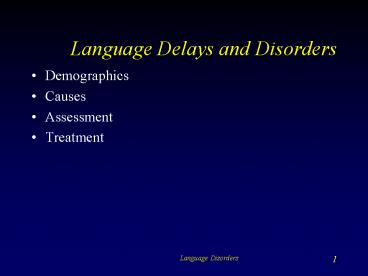Language Delays and Disorders - PowerPoint PPT Presentation
1 / 24
Title:
Language Delays and Disorders
Description:
Causes. Cognitive Delay. Hearing loss. Brain injury or disorder. Learning disability. Autism ... are delayed by about one year for every 10 dB of hearing loss. ... – PowerPoint PPT presentation
Number of Views:164
Avg rating:3.0/5.0
Title: Language Delays and Disorders
1
Language Delays and Disorders
- Demographics
- Causes
- Assessment
- Treatment
2
What is a language delay or disorder?
- Language delay
- Occurs when a child uses language typical for a
younger child. - Sometimes a child is considered delayed when
there is a one year discrepancy between their
language development age and their chronological
age. - Language disorder
- When the child or adult uses language which is
inappropriate regardless of developmental age.
3
Demographics
- Language disorders comprise the largest caseload
for school and pre-school SLPs.
4
Causes
- Cognitive Delay
- Hearing loss
- Brain injury or disorder
- Learning disability
- Autism
- Language depravation
5
Cognitive Delay
- Children with a CD tend to be delayed in all
phases of development including . . . - Motor skills
- Social development
- Self-care
- Language
- Intellectual and adaptive behavior
- Degree of CD will have an effect on language.
- For example, a child with a mild impairment might
have only a slight delay, while a child with
severe or profound CD may be non-verbal.
6
Hearing Impairment
- Mild loss
- Normally due to otitis media (middle ear
infection) and can cause a delay. In most cases
these children eventually catch up to their
peers. - Profound hearing loss (Deaf)
- Children typically never become proficient in
English grammar, but often will use American Sign
Language (ASL), which has their own unique
syntactic rules.
7
Hearing Impairment
- High frequency loss
- Hearing loss where they may not hear high
frequency speech sounds such as /s/ and /d/ which
might lead to difficulty with plurals (-s) and
past tense (-ed). - If unaided, children generally are delayed by
about one year for every 10 dB of hearing loss. - Early intervention with hearing aids or cochlear
implants is vital for language development.
8
Brain injury or disorder
- Might be a result of . . .
- Cerebral palsy or other neurological disorder
- Traumatic brain injury
9
Cerebral Palsy
- A neurological disorder that severely affects
coordination. - Besides affecting articulation, children may not
talk because of difficulty with coordination.
10
Traumatic brain injury
- Causes
- Result of auto accident
- Birth trauma
- Gun shot wound other trauma to the brain
- Damage to those areas of the brain important for
language.
11
Learning disability
- Child might have a specific learning disability
which prevents them from developing language
adequately. - Sometimes referred to as a functional disorder
since there is no none organic cause of the
disorder.
12
Autism
- Autism is behavioral disorder where the children
do not interact or minimally interact with
others. - This includes verbal interaction.
- Aversion to external stimuli
- Noise
- Touching
- distracting visual stimuli
- May have low, normal or high intelligence and may
perform specific tasks very well. - Important that intervention occurs at an early
age.
13
Language deprivation
- Parents do not talk to children
- Multiple children
- Children with serious health problems
- Deaf parents
- English Language Learners homes
- Parents with a CD
14
Assessment
- Screening
- Evaluation
15
Screening
- Purpose is to test a child to see if a possible
problem might exist. - Might involve a short spontaneous sample which is
informally evaluated by a speech-language
pathologist. - Short questionnaire for parents
- Formal screening test
- Other screening such as hearing and vision
16
Evaluation
- Language sample
- Case history
- Formal testing
17
Language sample.
- MLU
- Language structure (use of syntax) and semantics.
18
Case history
- Childs birth and neonatal history
- Childs medical history
- Family history
- Childs developmental history (e.g., when did
they start walking, talking, when did they first
say two words, etc.) - How does the child use receptive and expressive
language at home - Anything else not addressed.
19
Formal testing
- Standardized tests used to assess expressive and
receptive language. - Goal of these tests is to evaluate specific
linguistic areas (e.g., rules of morphology or
syntax) and knowledge of semantics. - Other testing including psychoeducational
testing, vision and hearing.
20
Language Treatment
- Treatment plan
- Sequence of treatment
- Treatment methods
21
Treatment plan developed by SLP
- E.g., the child might have difficulty with
morphology or specific areas of syntax such as
preposition, adjectives, or other parts of speech.
22
Sequence of treatment.
- Typically begins at a level child can master
- Gradually increases task complexity
23
Treatment methods
- Modeling, and self talk (SLP or others speaking
out loud) - Behavior modification
- E.g.,repeat after me, say this, etc.
- Cognitive approach
- Work on concepts and socialization instead of
language directly. Seems to work well with
socially disadvantaged children.
24
(No Transcript)































